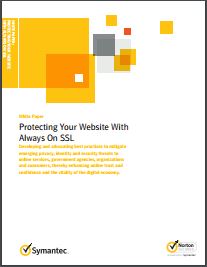Protecting Your Website With Always on SSL

Trust and consumer confidence is the foundation upon which the Internet has been built. Leading commerce and financial services companies worldwide have long used Secure Socket Layer and Transport Layer Security (SSL/TLS) technologies to secure customer communications and transactions.
But with the rise of Web 2.0 and social networking, people are spending more time online and logged in, and they are communicating much more than just their credit card numbers. Unfortunately, Web security practices have not always kept pace with these changes. Many organizations use the SSL/TLS protocol to encrypt the authentication process when users log in to a website, but do not encrypt subsequent pages during the user’s session. This practice is risky because it leaves website visitors vulnerable to malicious online attacks, and can result in millions of users being unknowingly exposed to threats simply by visiting a trusted website.
This white paper discusses the imperative need for Always On SSL, and the steps you can take to deliver end-to-end protection for your users. It also includes detailed accounts of four organizations—Facebook, Google, PayPal and Twitter—that are leading the way with Always On SSL in a cooperative effort to make the Internet more secure.


